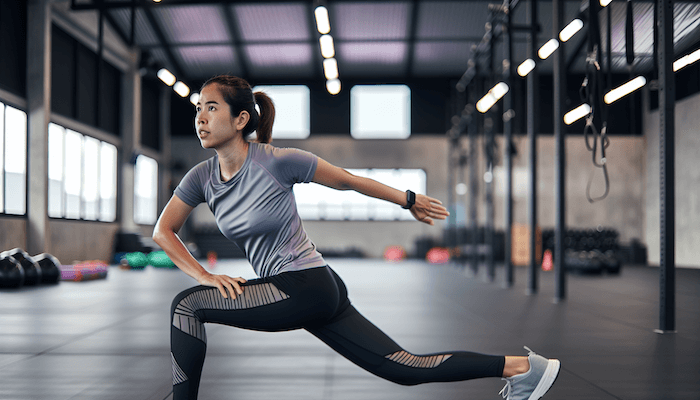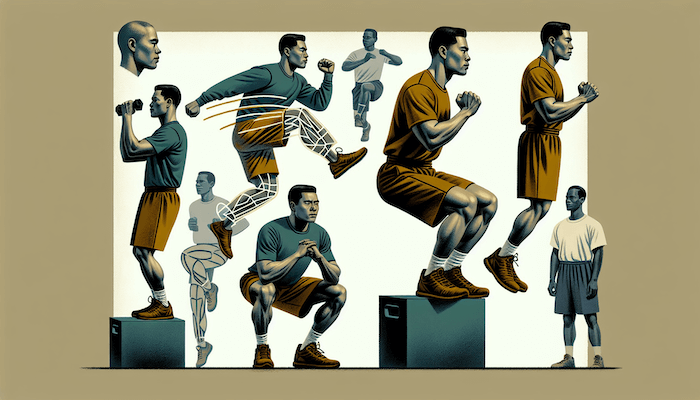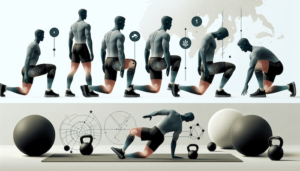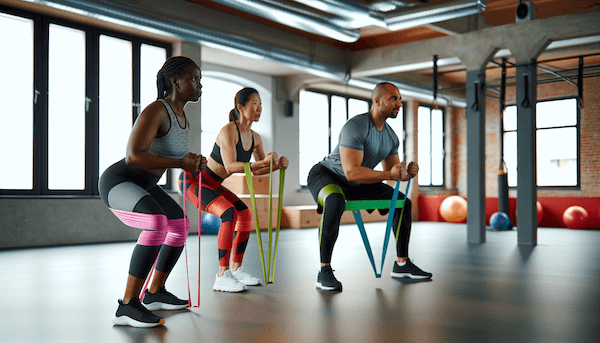Top Exercises on How to Build Knee Strength for Pain-free Mobility

Dealing with knee pain can be a daily struggle for many. But what if you could alleviate that discomfort through strengthening exercises?
This blog post will guide you on that journey, offering practical advice and exercises on how to build knee strength and mitigate knee pain. Let’s dive in!
Key Takeaways
Knee strength is essential for mobility, injury prevention and overall quality of life.
Exercises such as squats, lunges and leg presses can be used to strengthen the knee muscles while warm-up exercises are important for priming the knees prior to exercise.
Consult a healthcare professional before starting an exercise program or when experiencing severe pain in order to maintain healthy knees. Our resident injury rehab personal training expert Keith is a great person to talk to also!
Importance of Knee Strength
Knee strength is essential for everyone, regardless of whether you are an athlete, a fitness enthusiast or simply looking to stay mobile in daily life.
Powerful knees can not only make everyday activities easier, but also upgrade sports performance and help avoid injuries.
Weak knees can be the source of many issues such as bodily disparities and pain caused by overcompensation.
To prevent these problems from arising, it’s important to implement knee strengthening exercises into your routine – 15 minutes every day should go a long way towards improving both knee strength and overall quality of life within two weeks!
Role of Knee Muscles
When it comes to enhancing the strength of your knees, knowing which muscles play a role is vital. The primary purpose of knee muscles is not only providing overall mobility but stability too. An example would be performing calf raises as this engages the calves, which supports the knee joint.
The main players in keeping one’s kneecap strong are their glutes, quadriceps, hamstrings and yes, the crucial calf muscles.
All aiding together in assisting with absorbing shock during various activities by buttressing up support around that region when engaged e.g. doing hamstring curls works on engaging those thigh muscle components thus sustaining equilibrium for protection at said area ultimately placing emphasis on our knees itself.
Recognizing these particular muscular facets surrounding our knees leads us towards realizing how important they actually are for bettering its robustness.
Benefits of Strong Knees
Having powerful knees is beneficial for many reasons. They can provide relief from discomfort, prevent injury and improve physical capabilities, which ultimately boosts your life quality.
Some of the advantages include: enhanced mobility, decreased pain, improved athleticism and better support to protect knee joints.
For instance, doing a straight leg raise with the left leg activates the quadriceps muscles around it, causing less suffering in both legs along with more flexibility.
The same goes for exercises that focus on strengthening these parts as they reduce any pressure placed on joints while providing additional safety against future damage or hurting.
It also engages those areas’ muscles supplying assistance in balance, especially when you perform squats – which add to durability if done routinely –comprising stability plus efficacy of one’s activity levels notably concerning their own knees.
Warm-up and Stretching for Knee Health

Before starting any knee-strengthening exercises, it is important that you warm up and stretch your muscles around the joint. Simple activities like leg swings are good for warming up these areas before exercising in order to reduce strain on the knees and maintain flexibility.
For an existing injury, low impact exercises such as walking or cycling can be used beforehand too. They help heat up those muscles without doing damage. Take time out of each routine session – usually 5-10 minutes, solely dedicated to properly warming yourself up before jumping into more strenuous strengthening movements involving your knees.
Dynamic Warm-up Exercises
By incorporating dynamic warm-up exercises into your routine, you can prime the muscles and joints around your knees to better support physical activity. These exercises provide advantages such as increasing mobility in hips and knees, stretching hip flexors/glutes, activating quads/ glutes, boosting blood flow while warming up those same muscle areas. Thus diminishing stiffness too.
Some great examples are high knee jumps for a bit of cardio, but also leg swings which encourage overall body flexibility from head down to toes! This is an optimal way for improving heart rate before diving into training activities, like heel walks or toe walk drills plus multiple combinations of hug motion walking styles with one or both legs ending at chest level each time. Step ups could be included here as well though it will depend on individual preferences rather than guidelines since everyone moves differently under different conditions!
Key Stretches for Knee Flexibility
Maintaining the health of your knee requires a combination of warm-ups and stretching exercises. The more regularly these are done, the better. At least four to five times per week is suggested for ideal joint mobility and flexibility in the area around your knee.
Doing stretches that focus on lower body muscles can aid in providing greater range of motion and strength support to keep it healthy. Exercises like calf stretching, hamstring elongation, as well as quadriceps strengthening should be included into any routine involving looking after one’s knees.
These will enable easier movement from this part of our body while also improving overall muscle stability along with other associated benefits such as increased blood circulation near its surrounding areas when performing them properly over an extended period.
Top Knee Strengthening Exercises

Knee strength is a very important factor to take into account when doing exercises, and for that reason it’s worth taking some time to explore the top activities aimed at building key knee muscles. Some of these are directed towards different parts of the joint which can help you achieve stronger knees overall.
Half squats, straight leg raises, seated leg rises or squat/leg extension motions are all effective ways in strengthening your quadriceps as well as aiding knee health. Standing hamstring curls play an essential role too due to their targeting of back thigh muscles, providing significant support for said joint structure.
Quadriceps-focused Exercises

Targeting the quadriceps muscles is a key to reinforcing knee stability. This can be accomplished by performing squats, lunges, leg presses and step-ups as part of your workout routine, all great exercises for reducing the risk of injuries while increasing overall balance and durability at the same time.
Straight leg raises along with short arc quads will help target these important muscle groups more directly which has positive effects on your knees’ wellbeing To improve balance further. Wall slides together with terminal knee extensions plus split squats are really effective ways for adding variation to an exercise regime while still providing a much needed focus on strengthening these essential areas around this joint area.
Finally mini-squats provide even greater variety when combined with wide then narrowing stances making sure you work out each side similarly – doing so allows anyone looking towards better control over their lower limbs additional levels if intensity that may not have been present before.
All those mentioned above activities bring value from multiple standpoints: they lessen injury risks while simultaneously focusing upon bolstering already existing strength thus ensuring sturdy healthy legs no matter what physical exertion you’re up against!
Hamstring-focused Exercises
Strengthening your knees requires exercising both the quadriceps and hamstrings. In order to maximize results, glute-ham raises, Swiss ball curls or Nordic curls are suggested workouts for targeting those muscles.
It is important that you go slowly and be conscious of muscle engagement in order to avoid any harm while increasing resistance levels over time. Doing so will help guarantee knee stability without risking an injury.
Calf and Ankle Exercises
Strengthening the calf and ankle muscles plays an important role when it comes to knee function. Exercises like heel raises and ankle circles can support knee alignment while also promoting stability, balance, and proprioception in order to help reduce potential injury risk.
Various variations of this exercise which focus on isolating different parts of the muscle can be carried out as part of a tailored regime designed for healthy knees. Including these workouts should not be overlooked!
Exercise Progression and Modifications

If you are looking to build up strength in your legs and knees, it is important that any modifications or advancements of your exercises be done safely. Speak with a physical therapist or our own injury rehabilitation coach Keith O'Malley-Farrell first for their professional opinion before making any changes.
To add more challenge to the workouts, consider resistance bands, ankle weights or exercise rollers/balls as options. Low-impact activities such as swimming and cycling can also help progress towards stronger knees while modified versions of leg raises and planks could reduce strain depending on what level you’re at fitness wise.
Adding Resistance
Incorporating resistance into your knee strengthening exercises adds an extra challenge, with the potential to improve muscle strength and joint stability.
Resistance bands can be used for Clamshells, Knee Extensions, and Leg Lifts while dumbbells are ideal for squats or lunges. Gradually increasing weight as fitness improves is key.
Begin at a lighter level of difficulty before escalating resistance levels over time to avoid injury whilst maximising functional performance. By improving alignment during these specifically designed leg strengthening activities, you’ll benefit from enhanced endurance too!
Exercise Variations
Not everyone is at the same fitness level, and that’s okay. Whether you are a beginner, elderly or have limited mobility, there are exercise variations to fit your individual needs and preferences.
For beginners, straight leg raises, calf rises as well as knee extension using wall squats can be helpful for improving strength of their knees joint.
Elderly people will benefit from exercises like heel raise while lower themselves slowly with help of wall squats which provide an effective way to improve mobility in their legs.
Those with reduced ability to move should focus on quadriceps strengthening by doing short arc quads combined with terminal knee extensions followed by chair pose splits squat step-up sissy squats along walking lunges all together aiming good shape muscles supporting the specific part near our second biggest joints, the Knee Joint!!!
Tips for Maintaining Healthy Knees
Having a complete list of knee-strengthening activities in your hands, it’s also important to remember some other tips for taking care of the knees. Looking after this part of our body mainly requires two elements, regular exercise and suitable shoes.
Exercising on a daily basis not only keeps the muscles around that area toned up, but can also protect us from illnesses such as cardiovascular diseases, obesity or osteoporosis too.
On top of that, wearing correct footwear while doing any activity is essential so we have both balance and stability which will help prevent injuries related to these joints and keep them healthy overall.
Proper Footwear
When it comes to your knees, selecting the correct footwear is essential. Here are a few things you should consider when choosing: cushioning and support for reduced tension on the joints, proper alignment to reduce strain, increased balance in order to avoid injuries.
Appropriate shoes can help sustain knee health as well as mitigate discomfort or pain that may be linked with impacts of weight bearing activities on the left foot specifically.
When looking at potential options for purchase, make sure they include elements such as adjustable straps/laces so there’s a good fit plus firm heel cups and side posts offering lateral stability along with midsoles designed for shock absorption- arch supports built into design. Add comfort levels too while flexibility is also important factor together with solid construction.
Well known brands like Orthofeet Edgewater Stretch, Brooks Adrenaline GTS, New Balance running sneakers, HOKA shoes combined alongside cushioned ones from adidas Ultrabounce will meet all these criteria delivering reliable protection both now & later down the line fortifying kneecap safety & general wellbeing.
Posture and Alignment
To help promote optimal knee health, it is important to ensure proper posture and alignment during any exercise.
To accomplish this in the correct way, begin with a starting position that involves having your head, back, hips and feet all lined up shoulder-width apart as you keep both legs straight against the wall. Try not to lean backwards or let one leg lift higher than required.
Instead aim for an even weight distribution across both knees while keeping your upper body upright at all times without letting it move over toes when lifting either of them. You can use outstretched arms or hands on thighs for balance purposes too, if needed.
Low impact exercises such as swimming, cycling, yoga etc are good sources for strengthening muscles around joints whilst avoiding unnecessary stress put upon knees ; emphasise slowly bending those activities as well so tension stays minimal thereon.
Regular Physical Activity
Maintaining knee strength is essential and physical exercise plays a major role in that. Walking, cycling or using an elliptical machine are good ways to keep the quadriceps, glutes, and core muscles healthy, which help provide support for your knees.
It’s recommended to engage in these activities on at least two different occasions per week with each session lasting between 20-60 minutes. Aside from providing better joint health benefits, regular activity can also prevent cardiovascular disease issues such as obesity and osteoporosis.
Common Mistakes and How to Avoid Them
It’s very important to take the right precautions when doing knee strengthening exercises in order to avoid any potential injury. It is key that proper form be maintained while exercising, such as making sure your knees are bent and not overexerting yourself too much.
To safeguard against these mistakes, allow for adequate rest between workouts and start with a low intensity so you can gradually increase it over time without overwhelming the muscles or joint of your knees.
Always remember to slowly add more resistance so that your body gets accustomed accordingly. An abrupt change may place undue strain on them, which could result in pain or other issues related to joints or muscles within the knee area.
When to Consult a Healthcare Professional
Dealing with knee pain may require personalized exercises and adjustments, so it is wise to contact a doctor or physical therapist for professional advice prior to beginning an exercise program.
Symptoms such as sudden severe pain, swelling and warmth of the joint, inability to extend completely together with buckling or locking up should be attended right away since these might indicate more serious damage that could benefit from imaging tests.
Exercises can help strengthen your knees while simultaneously providing relief. Recognizing when you need external aid is equally essential.
Summary
We’ve come a long way, from understanding the importance of knee strength to learning about various knee-strengthening exercises and tips for maintaining healthy knees.
Remember, regular physical activity and the right footwear are just as crucial as doing the exercises correctly. And always listen to your body to avoid overexertion and injury. If you are worried about any pain in your joints like the knee, see a specialist, for the lower back and back pain for example you can see an expert neurosurgeon in Dubai.
Whether you’re an athlete or someone dealing with knee pain in daily life, strengthening your knees can significantly improve your quality of life. So don’t wait - start your journey to stronger knees today!
FREQUENTLY ASKED QUESTIONS ABOUT BUILDING KNEE STRENGTH
How can I make my knees stronger?
If you want to enhance the strength of your knees, leg and thigh exercises such as straight-leg raises, knee bends and hamstring stretches with contractions are some good options.
Doing these regularly will help fortify your legs’ condition better than before. Knee movements like this can be used for strengthening purposes since they target specific areas in those muscles surrounding the joint to make them stronger too.

